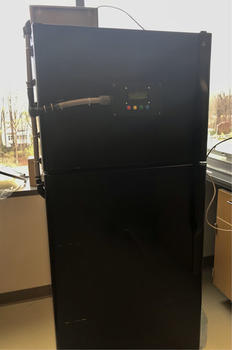In This Story

and humidity, using a computer program created
by Cameron Flores.
Mason engineering students are known for being resourceful in finding materials for their design projects all on an affordable budget. Electrical and Computer Engineering students, Cameron Flores and Nestor Arellano did just that with their senior design project building a sustainable refrigerator. This four-person team funded their project with their own money before receiving a $1,000 grant from the Patriot Green Fund.
Flores says his team looked at places like Facebook Marketplace and private sellers to find an average-cost fridge that would work for their project. “We went with what would be one [fridge] that we know that worked, two that did not smell, and three, was not infested with any ants or insects or cockroaches,” Flores says. They settled on a model, just under six feet tall, from a warehouse in Woodbridge and transported it from Arellano's work truck to their lab on the fourth floor of Peterson Hall. “Our budget was considerably smaller, and we had to go pick it up ourselves and move it around campus,” Arellano says.
Flores says the fridge works by regulating the temperature and humidity in the four coolers through manual input and automatic control. “They [consumers] put in one of the four pre-selected temperatures that they want.” The automatic setting evaluates the temperature and humidity of each cooler and balances it. “It will check the temperature levels and the humidity levels in each of them and look at the greatest difference.” The team’s goal is for produce to last longer in the fridge and reduce food waste, The students used fruits and vegetables such as kale, tomatoes, apples, and celery to test their hypothesis and a computer program for enabling the settings in the coolers.
These students received help from electrical and computer engineering Associate Professor Nathalia Peixoto and food science Associate Professor Margaret Slavin. Peixoto says the students were independent in building their project but that she helped them verify the technical components of it. “They wrote the proposal for the Patriot Green Fund, so they are the ones who got the money, which I’m really proud of,” Peixoto says.
Slavin says she produced the idea for a sustainable fridge after observing that most standard fridges in the U.S. do not lengthen the shelf life of produce. She contacted Peixoto, who presented the idea to the students. “I pointed them in the direction of the statistics,” Slavin says, in helping them design protocols and test the coolers’ preservation process. “We don’t foresee any decrease of energy consumption in our project,” Arellano says. “The original designers of the fridge probably achieved optimal energy consumption.”
The seniors and the faculty advisors both hope this project impacts Mason and beyond by raising awareness of food sustainability and healthy living. “I think its impact will be in a reduction of food waste and create a kind of domino effect. Also, influencing people to eat healthier if they are given that option,” Arellano says. Peixoto says she hopes more people will pay attention to food waste and take steps to lessen it. “I hope more people will be aware of the options when buying a fridge or that they can add, you know, a compartment to their fridge to make it more sustainable.”
